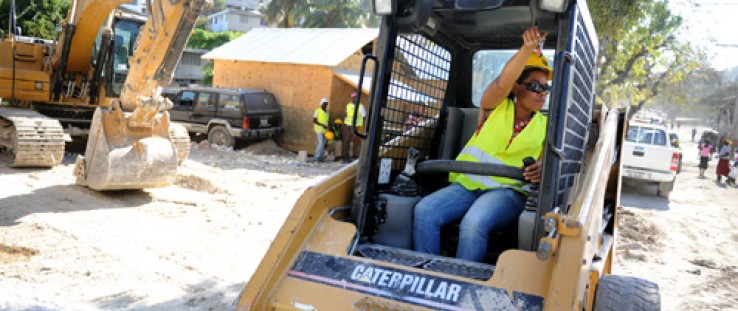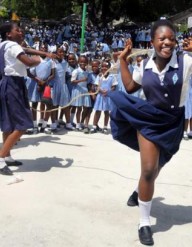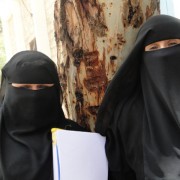 Kendra Helmer, USAID
Kendra Helmer, USAID
 Kendra Helmer, USAID
Kendra Helmer, USAID
PORT-AU-PRINCE, Haiti
The lurching roar of heavy machinery echoes through the Nazon neighborhood of Port-au-Prince. A heavy machine operator hops into what looks like a toy bulldozer—a skid steer loader. A giant shovel at the front of the tough little machine lifts a bulky piece of rubble as the nimble operator flips switches, turns knobs, and pulls levers from inside the cockpit.
The operator maneuvers again, and the shovel tilts until the rubble tumbles into the bed of a dump truck with a rock-on-rock knocking sound. Once the operator fills the bed, the engine surges and the truck fades into the distance.
The machine operator is not what one might expect: a strapping young man or seasoned construction worker. Instead, Judette Leurbours, a single mother of four, is one of the women driving the rubble removal progress in Nazon.
Leurbours, whose bright eyes sparkle under her hard hat and protective eye gear, watches the loaders pass her. Speaking loudly over the humming and grinding of machines, she says, "I always loved watching the heavy machinery operators. Since it is work that I love, I don't find it difficult at all."
Rubble: the Obstacle to Rebuilding
Leurbours learned to operate heavy machinery at the Haytrac Center, a CHF International training facility funded by the U.S. government through USAID's mission in Haiti. USAID also provides essential job-skills training to Haitians in other priority sectors such as agriculture and manufacturing.
"Rubble is one of the biggest challenges to reconstruction and recovery in Haiti," says USAID/Haiti Mission Director Carleene Dei. "The Haytrac Center project was designed before the earthquake to empower Haitians, including women, through long-term job creation. After the earthquake, these trainees have been in extremely high demand for their skills and are actively rebuilding their country."The 7.0 earthquake that struck outside Haiti's capital on Jan. 12, 2010, created a massive 10 million cubic meters of rubble. In the year since, the U.S. government has funded the removal of 1.3 million cubic meters, but there is a long way to go. Rubble removal in neighborhoods like Nazon, where nearly 70 percent of the houses were damaged or destroyed during the earthquake, is critical to rebuilding. New construction can't take place until the ground is cleared.
Leurbours is one of many Haitians involved in rubble removal, but she has also accomplished a great deal as a single mother in Haiti. She raised her four children "almost single-handedly," she says proudly.
She comes to work every day and joins her eight male and one female colleague. The team jokes around before climbing into their heavy equipment to start demolition and rubble loading.
"I love working in the team. When we have to do something on the site, we do it with solidarity and joy," she says, adding: "I love organizing where there is disorganization."
Homegrown Talent
CHF International and their partner Haytrac, Haiti's official Caterpillar dealer, operate the Haytrac Center. Since opening in 2009, it has trained 160 heavy machine operators, including 30 women, who are now contributing to the reconstruction effort in Haiti as well as helping ease, if only somewhat, the Caribbean nation's crushing unemployment statistics, estimated to be at 70 percent to 80 percent in the formal sector.
"The program was set up because there were hardly any Haitian heavy machinery operators—most of them had to be brought in from the Dominican Republic or the other places," said Alberto Wilde, CHF International's country director in Haiti.
And in a country with so many out of work, those jobs are too valuable to be shopped out abroad. The average monthly salary for a rookie heavy equipment operator, excluding weekly bonuses or other extras paid for a job, is around $950 per month for a seven-day work week. This equates to roughly six times the minimum Haitian salary of $5 per day. What's more, a more seasoned operator can make double and even triple this figure.
Machine operation jobs have traditionally gone to men in Haiti, and women rarely have the opportunity to learn construction skills.
"We wanted to break that stigma," says Wilde, explaining how difficult it is in Haitian society to accept that women are doing such a job. "We want to incorporate women and give them an equal opportunity—especially since we recognize that women are the drivers of the economy in this country, they are often the heads of households, bringing up the children."
Top of Her Class
Roselette Dupervil is another Haytrac-trained heavy machinery operator working at the Nazon rubble removal site.
"She is fast and works well," shouts CHF's Rubble Removal Manager Yrving Mehu over the crashing noise of Dupervil's excavator as it smashes into a badly damaged home to bring it down safely. "She is in my top three operators."
"She is really amazing. For all practical purposes, she shouldn't have been this far ahead this quickly, she is as good as someone with many more years of experience," says Haytrac Manager Patrick Bonnefil. Because of people seeing Dupervil on the big excavator, he explains, "I am getting a lot of demands and a lot of women that want to follow in her footsteps."
Dupervil is 23, single, and doesn't have children. She wants to keep it that way for now.
"My dream since childhood is to become a civil engineer," she says with a smile. Unable to pay for a civil engineering education, she took advantage of the Haytrac training since it covered the same field.
"I love my job," she says. "I want to become the best female professional to work in this domain."
Hopes for a Better Haiti
Leurbours hopes that her daughters and the younger female generation including Dupervil don't have to live in the Haiti she has lived in.
"Every day I dream of a better Haiti where all the Haitian women can live better. Because right now, they don't live in this country," Leurbours says. "They don't live because they are not included. The young girls become old before adulthood, such is their misery. The women who have had a chance to go to school and be professionally trained don't find work easily. Thus, in general, women get to know a sad reality. . . .
"I wish that the Haitian women could become trained, work, and become independent economically," she adds. "But, the most important [goal] is that this society learns to better value and appreciate its women."
Joanna Stavropoulos is the communications manager for CHF International Haiti.












Comment
Make a general inquiry or suggest an improvement.